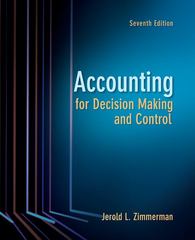These are the questions.
CASE 33 Precious Metals Just after their December examinations, four management accounting students, who had been team members in a management accounting course, met to con- sider an equity investment. A relative a young mining engineer had asked one member to evaluate a mining proposal, offering him the opportunity to become a shareholder. This new venture was to mine precious metals on a property that had in the past been considered to have too small of an ore body to be economically viable. Located about 500 kilometres north of Toronto, the mine in question is close to good roads. Moreover, as there is substantial unemployment in the area from the closure of other mines, there are sufcient appropriately skilled workers, with an expected average wage of $22 per hour. Five years ago, when unemployment levels in the province were low, an average wage of $25 might not have attracted the required labour force. Recent changes in the technology of mining equipment have made eco- nomical the mining of smaller properties. Test drilling surveying was done for the property's ore body. The survey concluded that the property has sufficient ore for a mine and processing plant operating for 20 years at 1,500,000 tonnes (1 tonne = 1,000 kilograms) per year. The expected yield is 0.05 percenti.e., for every tonne there will be 0.5 kilograms of the precious metal. The mining engineer estimated the equipment and plant at $38 million. Of the total assets, half has a CCA rate of 30 percent, one-third has a CCA rate of 20 percent, and the remaining one-sixth has a CCA rate of 10 percent. The assets will last for the life of the ore body, after which time the expected sal- vage value is $2 million; only assets subject to 30 percent CCA are salvageable. The estimated processing costs (excluding amortization or capital cost allowance) are $16 a tonne. Estimated administrative and selling costs are $4 million and $1 million per year, respectively. Working capital requirements are $1 million. An added initial investment of $1 million will recover other trace minerals. This would amount to 100,000 kilograms a year at 10 percent of the kilogram price of the precious metal. Operating costs and other costs would increase by 10 cents a tonne. There is no expected salvage value for these assets, which are in the 30 percent CCA class. 1 CASE 33: PRECIOUS METALS The mining engineer has spent $100,000 for the property, test drilling, incorporation, and solicitation for investors. The company must reimburse her upon start-up. She is also considering the idea of asking $5 million for the company. The price per kilogram of the precious metal is likely to uctuate because the metal is a material for luxury goods that varies in demand and price directly with the North American economy. A consulting economist used proba- bility analysis to present estimates of future prices: Frequency ('35) 30 20 15 - I I - $35 $40 $45 $50 $55 Future Price per Kilogram Precious Metals would be a typical mining company. Its key success factors would be market price for the metal, yield of the ore, and operating costs per tonne of ore. There is to be a board of directors to whom the general manager (i.e., the young mining engineer) would report. This board would need to approve the 20-year plan. The board also approves the annual budget and reviews the quar- terly performance in comparison to the budget. Otherwise, the general manager has complete autonomy in managing the mine. The team members have two other concerns: (1) the risk inherent in uc- tuations, and (2) that the young mining engineer will run the mine for her ben- efit and not the owners'. You and your team members had a long discussion about how the owners could be assured that she made decisions best for the company and not just herself. While the team members believed her to be hon- est, they all believed that differences in objectives could put the interests of the investors in jeopardy. The discount rate (R) is 8 percent after tax. The income tax (T) rate is 40 percent. Calculate the tax shield with the following equation (C is the CCA rate). For the first year, the half-year rule applies, and it is shown as the second part of the equation. T>









